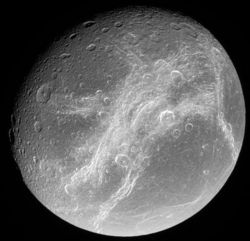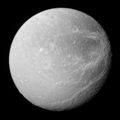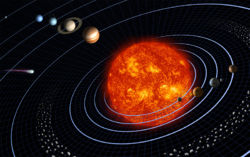Dione (Moon)
 From Conservapedia
From Conservapedia | Dione | |
|---|---|
 Bright cliffs on Dione, taken by spacecraft Cassini | |
| Date of discovery | March 21, 1684[1] |
| Name of discoverer | Giovanni Domenico Cassini[1] |
| Name origin | Titaness, sister of Kronos, mother (by Zeus) of Aphrodite[1] |
| Orbital characteristics | |
| Primary | Saturn |
| Order from primary | 13 |
| Perikrone | 376,570 km[2] |
| Apokrone | 378,230 km[2] |
| Semi-major axis | 377,400 km[3][4] |
| Orbital eccentricity | 0.0022[3] |
| Sidereal month | 2.736915 da[3][4] |
| Avg. orbital speed | 10.03 km/s[5] |
| Inclination | 0.02°[3] to Saturn's equator |
| Rotational characteristics | |
| Sidereal day | 2.736915 da[3] |
| Rotational speed | 14.9 m/s[2] |
| Axial tilt | 0°[3] |
| Physical characteristics | |
| Mass | 1.1 * 1021 kg[3] |
| Density | 1477.4 kg/m³[6] |
| Mean radius | 561.6 km[6] |
| Polar radius | 560.3 km[6] |
| Surface gravity | 0.223 m/s²[5] |
| Escape speed | 0.5 km/s[5] |
| Surface area | 3,940,800 km²[2] |
| Mean temperature | 86.59 K[5] |
| Composition | Water-ice mantle and rocky core[5] |
| Color | Neutral gray |
| Albedo | 0.7[3] |
Contents
Discovery and naming[edit]
Giovanni Domenico Cassini discovered Dione, along with the moons Tethys, Rhea, and Iapetus, in the latter half of the seventeenth century, during the reign of "Sun-King" Louis XIV of France.[1] Cassini named these moons the "Sidera Lodoicea" in honor of the king. Later generations (especially after the French Revolution) would not retain such regal flattery.[7]
Sir John Herschel, son of the astronomer William Herschel, suggested the current names of the seven largest satellites of Saturn, including Rhea. Titan received a generic name, and the other six received names of the Titans of mythology. Dione was the sister of Kronos or Cronus and mother (by Zeus) of Aphrodite.[8]
Orbital characteristics[edit]
Dione is in a somewhat circular orbit around Saturn, at an average distance of 377,400 km. Its sidereal month is about 2.74 Earth days.
Dione appears to be in a 2:1 orbital resonance with Enceladus, an inner moon. Some astronomers suggest that this causes significant tidal heating on Enceladus.[9]
Co-orbital objects[edit]
Dione shares its orbit with two other moons that occupy its Trojan points, with Helene in the leading point and Polydeuces in the trailing point.
Rotational characteristics[edit]
Dione is in tidal lock with Saturn, and thus always keeps the same face toward Saturn. Hamilton estimates that Dione has been locked in its present orientation for several billions of years, because its 70% albedo is evenly distributed between the leading hemisphere and the trailing.[5]
Physical characteristics[edit]
Dione is the third most dense moon of Saturn (after Enceladus and Titan). It likely consists of a silicate core and a water-ice mantle.
Surface[edit]
Surprisingly, most of Dione's craters are found on the trailing hemisphere, not the leading. Shoemaker and Wolfe have suggested, from their studies of the Galilean moons, that the leading hemisphere of any moon in tidal lock ought to have more craters than the trailing hemisphere.[10]
This has led some astronomers to propose that, in the time when many bodies in the solar system underwent heavy bombardment, Dione was in tidal lock in an orientation opposite to that which Dione now has with respect to Saturn. Hamilton suggests that any object large enough to create an impact crater 35 km or wider in diameter would have given Dione sufficient energy to turn itself 180° about and come to a new tidal lock. He also points out that Dione has a number of craters more than 100 km in diameter.[5]
Neukum et al. estimated that the surface of Dione, like those of several other moons of Saturn, must be geologically old on account of the number of craters found, and their distribution.[11]
Dione also has multiple linear streaks on its trailing hemisphere. Astronomers once thought that these resulted from a massive remodeling of the surface of Dione, and that a later period of bombardment erased the streaks on the leading hemisphere. Data from the Cassini orbiter has disproved this hypothesis. The streaks are now known to be tectonic fractures, many of which slice through the impact craters and are therefore geologically younger than the craters.[12][13]
Problems for uniformitarian theories posed by Dione[edit]
The greater concentration of impact craters on the trailing hemisphere defies the usual model for the bombardment of a body in tidal lock. Most astronomers therefore suggests that multiple impacts could have turned Dione about, perhaps multiple times, before Dione settled into its present orientation. But any object having enough momentum to turn the satellite about ought to have left it in a far more eccentric orbit than it is now in.
Observation and Exploration[edit]
The first spacecraft to visit Dione was Voyager 1, which took several high-quality images. The Cassini Orbiter has taken several images of much higher quality, especially on October 11, 2005, when Cassini made one targeted rendezvous with Dione. Mission planners have scheduled another rendezvous with Dione during the first two-year extension of the Cassini mission.
Gallery[edit]
Video[edit]
References[edit]
- ↑ 1.0 1.1 1.2 1.3 "Gazetteer of Planetary Nomenclature: Planetary Body Names and Discoverers." US Geological Survey, Jennifer Blue, ed. March 31, 2008. Accessed April 17, 2008.
- ↑ 2.0 2.1 2.2 2.3 Calculated
- ↑ 3.0 3.1 3.2 3.3 3.4 3.5 3.6 3.7 Williams, David R. "Saturnian Satellite Fact Sheet." National Space Science Data Center, NASA, November 23, 2007. Accessed June 4, 2008.
- ↑ 4.0 4.1 "Classic Satellites of the Solar System." Observatorio ARVAL, April 15, 2007. Accessed June 12, 2008.
- ↑ 5.0 5.1 5.2 5.3 5.4 5.5 5.6 Hamilton, Calvin J. "Entry for Dione." Views of the Solar System, 2005. Accessed June 12, 2008.
- ↑ 6.0 6.1 6.2 Thomas, P.C., Veverka, J., Helfenstein, P., et al. "Shapes of the Saturnian Icy Satellites." 37th Annual Lunar and Planetary Science Conference, 2006. Accessed June 12, 2008.
- ↑ Boulay, J. C. "Saturne: les satellites." Astronomie-astronautique. Accessed June 5, 2008.
- ↑ Lassell, William. "Satellites of Saturn." Monthly Notices of the Royal Astronomical Society, 8(3):42-43, January 14, 1848. Accessed June 4, 2008.
- ↑ Hubbard, William B. "Dione." Encyclopædia Britannica. 2008. Encyclopædia Britannica Online. 12 June 2008.
- ↑ Shoemaker, E. M., and Wolfe, R. F. "Cratering time scales for the Galilean satellites." Satellites of Jupiter, Tucson, Arizona: University of Arizona Press, 1982, pp. 277-339. Accessed June 12, 2008.
- ↑ Neukum, G., Wagner, R., Denk, T., et al. "The Cratering Record of the Saturnian Satellites Phoebe, Tethys, Dione, and Iapetus in Comparison: First Results from Analysis of the Cassini ISS Imaging Data." 36th Annual Lunar and Planetary Science Conference, 2005. Accessed June 12, 2008.
- ↑ Arnett, Bill. "Entry for Dione." The
Nine8 Planets, February 27, 2005. Accessed June 12, 2008 - ↑ "Entry for Dione." The Planetary Society, 2008. Accessed June 12, 2008.
| |||||||||||||||||||||||||||||
Categories: [Astronomy]
↧ Download as ZWI file | Last modified: 02/14/2023 03:21:23 | 10 views
☰ Source: https://www.conservapedia.com/Dione_(moon) | License: CC BY-SA 3.0
 ZWI signed:
ZWI signed:



 KSF
KSF